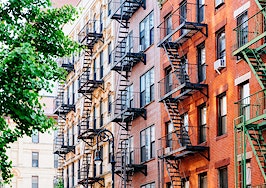It was May 16, 1979, when tragedy struck: Grace Gold, a freshman at Manhattan’s Barnard College was out for an evening walk when a piece of concrete from a nearby building broke off and hit her in the forehead.
According to the New York Times, the chunk of building measured 1-foot by 2-feet, and fell from the lintel above a window on the seventh floor.
“She was speaking to a friend,” Abdi Fassih, a witness to the accident, told the Times back in 1979. “Suddenly there was a big, crack on her forehead. She screamed and went down, choking and bleeding. It didn’t take more than five minutes and she was dead.”
The incident rattled a number of observers at the time — the Times piece includes several eye-witness accounts — but it also led to a watershed moment in New York City: On February 21, 1980, then-Mayor Ed Koch signed Local Law 10, which required regular inspections of the city’s building facades.
Then, almost exactly 18 years later, lawmakers, prompted by even more facade failures, further tightened regulations with Local Law 11.
The era of facade inspection scaffolding in New York City had finally arrived.

Scaffolding on a building in Manhattan. Credit: Philippe Intraligi, EyeEm and Getty Images
The impact of these laws has been to effectively transform New York City’s streetscape. Today, in denser parts of the city it’s difficult to walk more than a block or two without ducking under a tunnel-like shelter beneath towers of scaffolding. The scaffolding can linger in one particular place for weeks, months, or occasionally even years as experts comb over masonry that is in some cases more than 100 years old.
As the death of Gold illustrates, there’s a very good reason for this situation.
But today — 40 years after the first law passed and 22 years after the second — some have grown weary of navigating an endless forest of steel skeletons. Many New Yorkers grin and bear it, but the issue nevertheless shows how the city has had to engage in a delicate balancing act between public safety and private interest.
What exactly does the regulation require?
Local Law 10 — the one from 1980 — required a licensed professional to inspect buildings over six stories tall every five years. Significantly, however, the rule typically applied merely to the buildings’ street-facing facades. It also included exceptions for some buildings if, for example, they were set far enough back from the street.
The law also allowed inspectors to examine buildings with binoculars or telephoto lenses — meaning that it didn’t necessitate a vast scaffolding infrastructure.

A skyscraper covered in scaffolding near Grand Central Station in Manhattan. Credit: rankvandenBergh and Getty Images
By the late 1990s, however, it was becoming apparent that Local Law 10 wasn’t addressing all of the problems with New York City’s facades. In December 1997, for example, a piece of concrete that the Times said was the “size of a dining room table” fell seven stories from a Manhattan building and demolished part of a restaurant awning. The incident didn’t injure anyone, but it did happen just days after ornamental bricks also tumbled from the facade of the Belleclaire Hotel, also in Manhattan.
The most serious incident of that era, also in December 1997, involved the catastrophic failure of a brick facade on Madison Ave. The incident rained debris on the street below, forcing closures and evacuations. It took days to clean up.
These incidents fueled the passage of Local Law 11 in 1998, which was meant to close various gaps in the inspection process.

Scaffolding on a building in Manhattan’s West Side. Credit: Kathryn Donohew Photography and Getty Images
Among the most notable changes was a requirement for inspections to be hands on, meaning engineers would have to use scaffolding rather than stand across the street with binoculars. The law also required inspectors to look at more sides of a building, and included a more stringent repair-oriented classification system for flaws or weak points in the masonry.
What impact did the law have?
The most obvious outcome of New York’s facade inspection rules is that scaffolding has become ubiquitous across the city. And that’s at least in part because hands-on inspections are really involved.

Michael J. Franco
Michael J. Franco, a Compass broker in Manhattan, told Inman that the process can last months and lead to “literally almost a shroud over the whole building.” If significant problems are detected, repairs can push the timeline out even more.
“These things can stay on forever,” Franco said. “If the building has to undergo major facade repairs, that could take a year and cost tons of money.”
There are some extreme examples: Last December, the New York Post identified multiple buildings where scaffolding had been up for more than a decade. The Post interviewed one 21-year-old woman who could not remember a building without scaffolding, and who remembered playing on the supposedly temporary framework when she was young.

Scaffold and screening covers a massive building on a corner in Manhattan, leaving only streetlights and stop lights visible in the frame. Credit: Joseph O. Holmes, portfolio.streetnine.com and Getty Images
The “tons of money” Franco mentioned is another issue. A problem-free inspection on a smaller or medium-sized building might only run up costs in the thousands of dollars. But larger buildings that need repairs can, according to Franco, end up looking down the barrel of a million-dollar bill.
“It can be a real drag,” Franco, who also deals with these kinds of maintenance issues as a member of his own building’s co-op board, added.
Complaints that facade inspections drive up costs in Manhattan are also not new. In fact, they go all the way back to the beginning.
”This is going to be a major-league expense for many buildings,” real estate attorney James Samson complained to the Times in 1998 as Local Law 11 was passed. ”Just look up and down Broadway. All that wonderful ornamentation and all those cute little gargoyles are now going to have to be inspected.”

Scaffolding that creates a tunnel over a New York City sidewalk. Credit: AEvenson and Getty Images
The upside, though, is that the costs can in some cases become an incentive to move quickly.

Wendy Arriz
“You are paying to keep the scaffolding up,” Wendy Arriz, a broker with Warburg Realty, told Inman when asked about scaffolding that sits for prolonged periods of time.
Local Law 11 has also not entirely prevented falling debris in New York City. In December, a chunk of terra cotta dropped from a 17-story building near Times Square and killed a 60-year-old woman. And in 2002, a collapsing barber shop facade killed a 33-year-old man in the Bronx.
It’s impossible to say how many similar accidents were prevented in recent decades thanks to Local Law 11, though presumably the answer is at least some. The deaths over the years also show that it is an issue with the highest possible stakes.
According to Arriz, that’s something most New Yorkers get at this point.
“People are more accustomed to it,” she said. “Everyone wants the city to be safe.”
So how does this impact real estate in New York City?
Inman reached out to numerous real estate professionals to find out if, and how, the scaffolding in New York might impact real estate. The take away is that while no one is especially thrilled to have a building encased in scaffolding, life goes on and the real estate industry generally does not see the presence of scaffolding as a major deterrent to buyers and renters.

Bonnie Chajet
“I think people will be understanding,” Bonnie Chajet, also of Warburg Realty, told Inman. “While they may not love it, I think most New Yorkers are now used to this.”
Still, there are issues.
Chajet said that she recently represented an apartment for which a potential buyer came forward. Then scaffolding started going up around the building.
“It turned the buyer off,” she recalled. “They haven’t come forward with an offer.”
It was the first time something like that happened to Chajet, and to be clear other real estate professionals who spoke with Inman said they had not lost sales thanks to scaffolding. But even when sales do go through, scaffolding can put a damper on things.
“It’s a little bit of a deterrent,” Chajet said, “when you’re showing something with park views and there’s scaffolding up.”

A brick building with scaffolding against its facade. Credit: amygdala_imagery and Getty Images
Franco offered a similar perspective, saying that “there’s definitely an impact” on real estate from scaffolding, particularly in units on the lower floors of a building.
“If you have a second- or third-floor apartment, it really blocks your view,” he said. “That’s a definite negative if you’re on a lower floor.”
Arriz recently found herself in that very situation: She was tasked with selling a lower-level unit. In the end, the seller opted to wait until the scaffolding around the building was removed.
“It really kind of blocked off the windows,” Arriz said of the unit.
Some buyers may also have concerns about safety, Franco said, given that scaffolding can be relatively easy to climb and thus offers would-be burglars access to a building. Still, housing is in demand in New York, so people mostly bite the bullet.
“I’ve never had a personal experience where somebody says, ‘I’m not going to buy because of the scaffolding,'” Franco added.
Views and safety notwithstanding, one of the other biggest questions that scaffolding raises when it comes to real estate is how much it’ll cost individual unit owners. That’s because many New York buildings are cooperatives, or co-ops, that are collectively owned by the people living in them. And that means that those people have to foot the bill for repairs.

Nicole Beauchamp
Nicole Beauchamp, an agent with Engel & Völkers, told Inman that co-ops typically have two ways of paying for facade inspections and the ensuing maintenance: Either they have a cash reserve they tap into, or they create an assessment — essentially an extra charge that the owner-occupants have to pay, sometimes over time.
And if there was an assessment, that’s something prospective buyers are going to want to know.
“I think ultimately you want to know why the scaffolding is up, how long it’s been up for, what work was performed and if there was an assessment,” Beauchamp said.
Arriz added that understanding how the inspection and repairs are paid for can offer a glimpse into a building’s financial health.
“Maybe somebody doesn’t want to live in a building where there aren’t adequate reserves,” she explained.

A street in Manhattan, underneath scaffolding. Credit: James Trosh and Getty Images
People buying into co-op buildings will find out about any assessments during the due diligence process of a transaction, and assessments aren’t a regular deal breaker. Arriz, for example, said she so far hasn’t had clients back out of deals over assessments, though it could happen.
“I’ve never had that before, but I imagine it does happen,” she added,” where people don’t want to live in a building.”
New York isn’t the only place struggling with this issue
Though New York City is most famous for ubiquitous scaffolding, other cities have at times struggled with related issues. In Boston, for instance, two people were injured in 2018 when a building facade collapsed on them. After the incident, The Boston Globe reported that such failures are not unusual.

A building in downtown Boston covered in scaffolding. Credit: AEvenson and Getty Images
Chicago, too, has faced facade issues. Last September, officials ordered the demolition of a building after its facade collapsed and injured a man. Another facade collapse in 2018 dumped a pile of bricks into a street, though no one was injured in that incident. And most tragically, one person was killed and three more injured in 2014 by bricks that fell from a building.
Boston and Chicago both have facade inspection ordinances. However, in each case the rules are limited to taller buildings and are more similar in scope to New York’s Local Law 10 from 1980 than to the more stringent regulation from 1998. It is probably no coincidence, then, that neither Boston nor Chicago are known for being engulfed in scaffolding the way New York City is.
And in that way, these cities — and others all over the world with much older buildings than anything in the U.S. — represent philosophically different attitudes about safety, public space, and private property. Who, for example, should get to control the airspace outside a window? Or, how should cities balance the need to keep sidewalks safe from falling debris against the need to have those same spaces unobstructed and usable? And how far can regulation go when it comes to eliminating urban fatalities?

Scaffolding over a sidewalk in SoHo. Credit: Marilyn Nieves and Getty Images
The amount of scaffolding in different cities suggests that different places have different answers to these questions. And in New York’s case, the city has chosen to prioritize safety even if it means sacrificing some views, or having scaffolding tunnels that stay up for months or years.
Some critics may call New York City’s solution a scourge. But for a lot of New Yorkers, its just part of living in the city.
“To me it’s part of New York,” Franco said. “I’ve been in New York for 27 years. In real estate for 20 years. And it’s part of the fabric of New York.”













